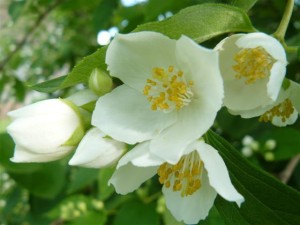I hate to admit it, but my mock orange is sad. The advent of spring and the deluge of recent rain have persuaded it to leaf out and I expect that flowers will not be far behind. Those flowers will be fragrant and beautiful, as always. Still, the shrub is more than five years old and has never achieved its full potential. It is crying out for some TLC, most likely in the form of relocation to a better spot. I can hear its piteous cries whenever I go out in the garden and I know I will have to take action if I want horticultural peace.
Over the centuries many people have loved mock orange or Philadelphus, a genus that includes a group of species that have long been cottage garden favorites. In fact, the Latin species name, “coronarius” means “garland”, which is probably indicative of the uses to which flowering branches were once put.
For years I thought the generic name “philadelphus” had something to do with Philadelphia, the “City of Brotherly Love”. However, the truth is a little more intriguing. The original Greek word, “philadelphus” means brotherly or sisterly love. The great taxonomist Linnaeus harkened back to his classical education and named the mock orange genus in honor of Ptolemy II Philadelphus, an ancient Egyptian pharaoh and son of one of Alexander the Great’s most successful generals. In his time, Ptolemy Philadelphus caused quite a stir by marrying his sister, Arsinoe II, bringing new meaning to the phrase “brotherly love”. Whatever we think of Ptolemy’s marital habits, we can still love the shrubs named after him.
Probably the best known and most popular mock orange is the deciduous Philadelphus coronarius, which sports characteristic, white, four-petaled flowers in mid-spring, at about the same time that lilacs commonly bloom. Those flowers are renowned for their sweet scent, which reminds some people of the fragrance of orange blossoms. Occasionally specimens lack that special scent, which is why it is a good idea to buy the plants in flower and sniff before brandishing your credit card.
Mock orange is not as popular as it once was, probably because we demand so much more of our garden plants these days. Like its fellow spring bloomer, forsythia, common mock orange enjoys about two weeks of glory when it flowers, before subsiding into an unremarkable leafy state for the rest of the growing season. Some species and varieties offer more value, but they tend to be harder to find.
The easiest remedy for the species’ deficiencies is grooming. After the flowers fade, you can either cut back about one third of the oldest stems and trim the plant to shape, or cut all the stems back almost to ground level. The latter is also a good way to control the size of larger varieties and species like western mock orange. Either way, annual pruning ensures that the shrub will develop a well-branched form that will not succumb to the unattractive legginess common in untended mock oranges.
Another remedy for the “two weeks of interest” issue is to choose species and varieties that work harder in the garden. Philadelphus coronarius ‘Aurea” features foliage that emerges gold in spring and turns a cooling shade of lime green in summer. The white single flowers exude the characteristic citrusy scent on shrubs that reach five to six feet tall and four feet wide. ‘Aurea’ has won the Royal Horticultural Society’s Award of Garden Merit or AGM.
‘Belle Etoile’—Philadelphus x lemoinii ‘Belle Etoile’–bred by the great nineteenth century French plantsman, Victor LeMoine, sprouts smaller, more refined leaves than the coronarius varieties, and larger white flowers with distinctive maroon blotches at the base of each petal. A happy ‘Belle Etoile’ covers itself with blooms.
Canadian-bred ‘Snow Dwarf’ is perfect for small-space gardening, and, at two to three feet tall and wide, can also be grown successfully in large containers. The blooms are double and fragrant.
Philadelphus lewisii or western mock orange is a North American native first collected by Meriwether Lewis during the Lewis and Clark Expedition. Though it is large at six to ten feet tall, it also offers more than one season of interest. The fragrant flowers appear in summer, along with green, ovate leaves. Those leaves turn yellow in fall, before dropping and revealing the attractive exfoliating bark on the stems.
Mock orange likes full sun–especially in the north–filtered sunlight or very light shade and consistently moist soil. A two-inch layer of mulch spread around, but not touching the plant’s base, helps to conserve that moisture.
Digging Dog Nursery stocks a good selection of mock orange species and varieties. Find them at 31101 Middle Ridge Road, Albion, CA 95410, (707) 937-1130; www.diggingdog.com. Free print catalog. ForestFarm carries Philadelphus lewisii, and can be reached at 14643 Watergap Rd, Williams, OR 97544, (541) 846-7269; www.forestfarm.com. Free print catalog.

